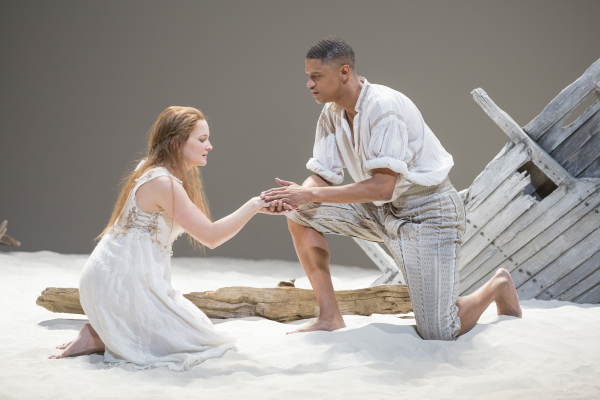The Tempest

(© Scott Suchman)
In what is often thought to be Shakespeare's final play, a masterpiece full of magic, romance and forgiveness, the Shakespeare Theatre Company's production of The Tempest pays great attention to the sound of language and music, confining the action to a simple sand dune looking out to sea. The result is a brilliant new vision of the play.
Running at Sidney Harman Hall, The Tempest takes place on an island where the magician Prospero (Geraint Wyn Davies), the deposed Duke of Milan, has lived with his 15-year-old daughter, Miranda (Rachel Mewbron), for the past 12 years. Prospero is attended by a heaven-bound sprite, Ariel (Sofia Jean Gomez), and an earth-bound prisoner, Caliban (Clifton Duncan). The first scene shows Prospero raising a horrific storm to destroy a vessel off his island's coast. The ship carries various lords, including Prospero's brother, Antonio (Gregory Linington), who betrayed him. The ship sinks but Prospero makes certain the lords make it to shore, so he can manipulate them through his magic.
There are a few plot lines in The Tempest, and director Ethan McSweeny masterfully blends them together. In an early scene in the play, five lords from the sunken ship appear and Antonio and Sebastian (David Bishins) reveal their hatred of the others.
Antonio persuades Sebastian to kill King Alonso (C. David Johnson), and Gonzalo (Ted van Griethuysen) while they sleep. But before they can do the deed, Ariel swoops in, crying "Awake! Awake!" and their plot is foiled. At a different moment, Alonso's son, Ferdinand (Avery Glymph), meets Miranda, who has never seen a human being other than her father. They instantly fall in love, never realizing that Prospero has deliberately brought them together. The third group exists purely for comic relief. A jester, Trinculo (Liam Craig), and a butler, Stephano (Dave Quay), meet Caliban and lose all reason in a wild night of drinking. Yet underneath the laughter is Caliban's intense resentment of his master.
Davies is a strong Prospero, a figure who prides himself on his absolute authority, but who simultaneously misses the more conventional engagement with humanity he had in his former life. He is a delightfully credible father, who tests Ferdinand, his future son-in-law, even though he brought Ferdinand and Miranda together.
Mewbron is a charming Miranda. She initially appears holding a doll, which she quickly flings into the wings on first seeing Ferdinand. As Ferdinand, Glymph is a perfect match for Miranda, noble and respectful of her powerful father.
One of the finest relationships is between Prospero and Ariel, who flies in quickly whenever summoned by her master (Stu Cox is the flying director). At times, Gomez plays Ariel as a stubborn teenager, her short blond hair twisted into punk-rocker peaks. At other moments, she is a willing servant, thrilled to help Prospero.
Prospero and Caliban, however, have no such close relationship. Duncan is a muscular, earth-bound slave, and his anger at Prospero is intense.
Of the waterlogged lords, only van Griethuysen's Gonzalo stands out as a person who understands nobility as Prospero does. In one scene, Craig and Quay create a vaudeville act worthy of a return ticket to Milan.
There is much music woven into this production, some of it created by Jenny Giering, some of it adapted from the original text. In a particularly beautiful scene, during a masque, Nancy Anderson appears on a balcony high above the stage, singing an accompaniment that introduces the members of the masque, larger-than-life puppets representing Iris, Juno, and Ceres (crafted by puppet designer, James Ortiz).
The superior tech systems of Sidney Harman Hall allow lighting designer Christopher Akerlind and sound designer Nevin Steinberg to create a spectacular storm to open the show.
Lee Savage's set design focuses the action within a huge, golden proscenium arch. Inside that arch is the stretch of sand, which is the locus for every scene. Beyond the sand is the pale beige sky, across which travels an off-white sun.
Jennifer Moeller's costumes for the inhabitants of the island reflect the same sand-colored palette used by Savage. The visitors wear black and brown. Helping to further tie the production together is Matthew Gardiner, whose choreography keeps the huge cast and ensemble flowing smoothly.
McSweeny and his team include all the complexity that Shakespeare gave The Tempest, and they do it in a refreshingly new way. Instead of familiar mossy trees and beaches crusted with shells, this Tempest locates the drama in a stunning verbal and visual simplicity, balancing the usefulness of Prospero's art with his renunciation of it and celebrating the two most important elements Shakespeare addressed in the play: love and reconciliation.










